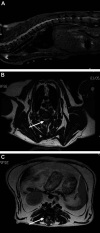Acupuncture treatment for feline multifocal intervertebral disc disease
- PMID: 19186087
- PMCID: PMC11132572
- DOI: 10.1016/j.jfms.2008.11.013
Acupuncture treatment for feline multifocal intervertebral disc disease
Abstract
A 14-year-old male neutered domestic shorthair cat was admitted to the Veterinary Medical Center, University of Minnesota for evaluation of severe hind limb ataxia, atrophy and paresis. Diagnosis based on physical examination, neurological assessment and magnetic resonance imaging (MRI) was multifocal intervertebral disc disease (IVDD) with dorsal disc protrusion throughout the thoracic and cranial lumbar spine. The Oriental Medicine (OM) diagnosis (pattern identification) was painful obstruction (Bi) syndrome caused by phlegm-heat accumulation with blood stagnation in the spine. High dose prednisolone therapy (1.25mg/kg PO, once daily) initially did not show any significant improvement in clinical signs. The cat was then treated with several modes of acupuncture treatment including dry needle acupuncture, electro-acupuncture and scalp acupuncture along with Tui-Na (hand manipulation in OM) and physical therapy. Significant improvements in mobility, proprioception and spinal posture were noticed and the cat was able to rise, walk and run 4 months after starting acupuncture treatments. This is the first case report of feline IVDD with multiple sites of disc compression which was successfully treated with several modes of acupuncture treatment.
Figures


Similar articles
-
Acute intervertebral disc extrusion in a cat: clinical and MRI findings.J Feline Med Surg. 2002 Mar;4(1):65-8. doi: 10.1053/jfms.2001.0150. J Feline Med Surg. 2002. PMID: 11869056 Free PMC article.
-
Chronic intervertebral disk herniation associated with fused vertebrae treated by vertebral lateral corpectomy in a cat.Vet Comp Orthop Traumatol. 2009;22(2):170-3. doi: 10.3415/vcot-08-06-0047. Vet Comp Orthop Traumatol. 2009. PMID: 19290402
-
Spinal magnetic resonance imaging in cats: differences in clinical significance of intervertebral disk extrusion, intervertebral disk protrusion, and degenerative lumbosacral stenosis.J Am Vet Med Assoc. 2024 Jul 8;262(9):1193-1200. doi: 10.2460/javma.24.02.0099. Print 2024 Sep 1. J Am Vet Med Assoc. 2024. PMID: 38977003
-
Spontaneous lumbar intervertebral disc protrusion in cats: literature review and case presentations.J Feline Med Surg. 2000 Dec;2(4):207-12. doi: 10.1053/jfms.2000.0098. J Feline Med Surg. 2000. PMID: 11716620 Free PMC article. Review.
-
Acupuncture for Small Animal Neurologic Disorders.Vet Clin North Am Small Anim Pract. 2018 Jan;48(1):201-219. doi: 10.1016/j.cvsm.2017.08.003. Epub 2017 Oct 14. Vet Clin North Am Small Anim Pract. 2018. PMID: 29037432 Review.
Cited by
-
Outcomes of surgically and conservatively managed thoracolumbar and lumbosacral intervertebral disc herniations in cats.J Vet Intern Med. 2024 Jan-Feb;38(1):247-257. doi: 10.1111/jvim.16950. Epub 2023 Dec 26. J Vet Intern Med. 2024. PMID: 38148600 Free PMC article.
-
Feline musculoskeletal ageing: How are we diagnosing and treating musculoskeletal impairment?J Feline Med Surg. 2020 Nov;22(11):1069-1083. doi: 10.1177/1098612X20965832. J Feline Med Surg. 2020. PMID: 33100170 Free PMC article. Review.
-
Acupuncture and Traditional Chinese Veterinary Medicine in Zoological and Exotic Animal Medicine: A Review and Introduction of Methods.Vet Sci. 2022 Feb 9;9(2):74. doi: 10.3390/vetsci9020074. Vet Sci. 2022. PMID: 35202327 Free PMC article. Review.
-
Veterinary acutherapy in management of musculoskeletal disorders: An eye-opener to the developing countries' veterinarians.Open Vet J. 2020 Oct;10(3):252-260. doi: 10.4314/ovj.v10i3.2. Epub 2020 Jul 29. Open Vet J. 2020. PMID: 33282695 Free PMC article. Review.
-
Evaluation of Safe Insertion Angles for Spinal Needles and Safe Intensity of the Holmium:YAG Laser during Percutaneous Laser Disc Ablations in Feline Cadavers.Vet Sci. 2024 Jul 18;11(7):325. doi: 10.3390/vetsci11070325. Vet Sci. 2024. PMID: 39058009 Free PMC article.
References
-
- Battistella MS. Human and small animal scalp acupuncture point comparison. Proceedings of the 13th Annual International Congress on Veterinary Acupuncture, 2004: 237–41.
-
- Xu X.C. Chinese Tui Na massage: the essential guide to treating injuries, improving health and balancing Qi, 2002, YMAA Publishing Center: Boston, MA, USA.
-
- King A.S., Smith R.N. Degeneration of the intervertebral disc in the cat, Acta Orthop Scand 34, 1964, 139–158. - PubMed
-
- Harris J.E., Dhupa S. Lumbosacral intervertebral disc disease in six cats, J Am Anim Hosp Assoc 44, 2008, 109–115. - PubMed
-
- Jaeger G.H., Early P.J., Munana K.R., Hardie E.M. Lumbosacral disc disease in a cat, Vet Comp Orthop Traumatol 17, 2004, 104–106.
Publication types
MeSH terms
LinkOut - more resources
Full Text Sources
Medical
Miscellaneous

